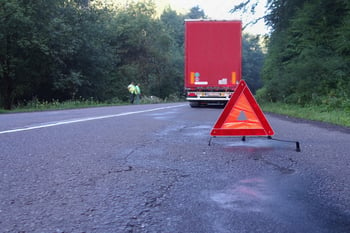
Proper placement of Warning Devices such as triangles when stopped or out of service on the side of the road is imperative to keeping you and other motorists safe. When placed correctly, Warning Devices can help save you and others from danger and or life-threatening injuries.
Below are the FMCSA guidelines that should be followed when placing Triangles and other important Warning Devices.
-
- If a vehicle is stopped on a highway or shoulder for a reason other than a necessary traffic stop, the driver must turn on the vehicle’s hazard warning system, which is to be left on until the vehicle’s external warning devices are in position.
- The hazard warning system must again be utilized when the warning devices are being picked up before the vehicle moves on.
- Placing your Triangles or any other warning devices should be top priority and should be placed as quickly as possible.
- Warning devices (warning triangles, fuse flares, or liquid-burning flares) must be placed within 10 minutes in three locations:
- One triangle or warning device on the traffic side of and 4 paces (approximately 3 meters or 10 feet) from the stopped commercial motor vehicle in the direction of approaching traffic.
- One at 40 paces (approximately 30 meters or 100 feet) from the stopped commercial motor vehicle in the center of the traffic lane or shoulder occupied by the commercial motor vehicle and in the direction of approaching traffic.
- If on a divided 2-lane road add the following: One at 40 paces (approximately 30 meters or 100 feet) from the stopped commercial motor vehicle in the center of the traffic lane or shoulder occupied by the commercial motor vehicle and in the direction away from approaching traffic.

Placing Warning Devices including triangles properly can be challenging depending on where the vehicle is stopped such as hills, bends or curvy roads. It’s important to familiarize yourself with the complete chapter specifically, CFR 392.22 to review all of the precautions required when stopped in areas other than a straight away. It just may save a life!


%20Cropped.jpg)



